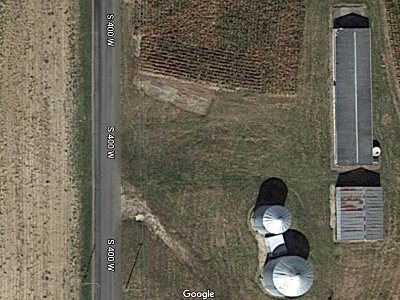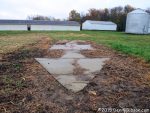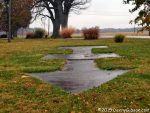 Like the first My Caboodles chapter, this third installment contains just three items. Some might consider it less than a full caboodle and I suppose, if a National Caboodle Association is ever formed, I might be called out on it. Here’s my thinking.
Like the first My Caboodles chapter, this third installment contains just three items. Some might consider it less than a full caboodle and I suppose, if a National Caboodle Association is ever formed, I might be called out on it. Here’s my thinking.
In the early days of powered flight, large concrete arrows were placed along the path of airplane routes as navigation aids. I was recently reminded of these arrows when Facebook (and real-life) friend Nick Gerlich posted a picture of an arrow in Texas. In his post, Nick noted that he had visited 47 arrows and had 78 to go. The fact that he mentioned a “to go” number indicates a plan, or at least a hope, of eventually reaching all 125 arrows that are known to exist today. What a great and natural caboodle, I thought, and I’ve a hunch that Nick just might reach them all, but I’m quite certain that I won’t. Some are in some rather remote locations that the much-fitter-than-me Nick will probably reach but which I wouldn’t even consider.
I’ve only seen three navigation arrows but they were all in Indiana, and, as benefits this series, they are all that exist in Indiana. The 125 arrows documented at Arrows Across America and scattered throughout the USA are an impressive and worthwhile caboodle but it’s out of my league. This is my blog and I make the rules. This post celebrates the three arrow Indiana sub-caboodle.
When created, the installations were originally known as Beacon Stations since their most important feature was an electric beacon mounted on a tower standing on the square pad in the middle of the arrow. The “feather” pad held a shed housing a generator if necessary. None of the Indiana arrows retain their towers, sheds, or fuel storage facilities.
 1. This is arrow #6 of Contract Air Mail Route #24 which connected Cincinnati to Chicago with a stop in Indianapolis. It’s on private property southwest of Rushville and is the arrow shown in the Google Maps image at the top of this article. The route began about 65 miles away at the historic and still operating Lunken Airport. Embry-Riddle Company, which had been founded at Lunken exactly two years earlier, won the contract. Their slogan for the new service was “Mail Airly and Often.”
1. This is arrow #6 of Contract Air Mail Route #24 which connected Cincinnati to Chicago with a stop in Indianapolis. It’s on private property southwest of Rushville and is the arrow shown in the Google Maps image at the top of this article. The route began about 65 miles away at the historic and still operating Lunken Airport. Embry-Riddle Company, which had been founded at Lunken exactly two years earlier, won the contract. Their slogan for the new service was “Mail Airly and Often.”
 2. Arrow #7 of CAM #24 is about eight miles west of #6. It’s east of Shelbyville and also on private property. There’s a Google Maps view here. This arrow looks to be in the best shape of all the Indiana arrows. Most or all of the concrete arrows were constructed between 1926 and 1932. CAM #24 began operating on December 17, 1927, and I imagine the route’s beacons and arrows were in place in advance of that. It doesn’t look too shabby for being roughly ninety years old.
2. Arrow #7 of CAM #24 is about eight miles west of #6. It’s east of Shelbyville and also on private property. There’s a Google Maps view here. This arrow looks to be in the best shape of all the Indiana arrows. Most or all of the concrete arrows were constructed between 1926 and 1932. CAM #24 began operating on December 17, 1927, and I imagine the route’s beacons and arrows were in place in advance of that. It doesn’t look too shabby for being roughly ninety years old.
 3. This is CAM #24’s Arrow #8. It is at the Shelbyville airport situated northwest of town. It is separated from Arrow #7 by almost exactly eight miles which I’m guessing is some sort of standard. A Google Maps view is here. There are some visible differences between this arrow and the other two and I’ll offer up some guesses as to why. One difference is the painted surface rather than bare concrete. The arrows were originally supposed to be chrome yellow and my guess is that someone, possibly an airport employee, is maintaining the historical accuracy of the arrow. A rather obvious difference is the lack of a “feather” pad at the tail end of the arrow. Although it’s possible that a pad once existed and has been removed, it seems more likely that one was never there. Where an electrical connection was available to power the beacon, no generator was required which meant no shed and no pad. It seems reasonable to believe that electric power was available at the airport. A third difference that might not be as obvious is the square pad and the arrow being slightly askew. The beacons were thought of first and the idea of directional arrows came along a short while later. This is only a guess, but I’m thinking the pad for the tower was poured first and not aligned with anything in particular. When an arrow pointing to Indianapolis was added, its alignment differed from that of the pad by just a skosh.
3. This is CAM #24’s Arrow #8. It is at the Shelbyville airport situated northwest of town. It is separated from Arrow #7 by almost exactly eight miles which I’m guessing is some sort of standard. A Google Maps view is here. There are some visible differences between this arrow and the other two and I’ll offer up some guesses as to why. One difference is the painted surface rather than bare concrete. The arrows were originally supposed to be chrome yellow and my guess is that someone, possibly an airport employee, is maintaining the historical accuracy of the arrow. A rather obvious difference is the lack of a “feather” pad at the tail end of the arrow. Although it’s possible that a pad once existed and has been removed, it seems more likely that one was never there. Where an electrical connection was available to power the beacon, no generator was required which meant no shed and no pad. It seems reasonable to believe that electric power was available at the airport. A third difference that might not be as obvious is the square pad and the arrow being slightly askew. The beacons were thought of first and the idea of directional arrows came along a short while later. This is only a guess, but I’m thinking the pad for the tower was poured first and not aligned with anything in particular. When an arrow pointing to Indianapolis was added, its alignment differed from that of the pad by just a skosh.

Never heard of these arrows. Thanks for bringing them to my attention.
Looks like you could just about clinch Illinois over lunch. There’s just one arrow left and it’s less than ten miles south of Rochelle.